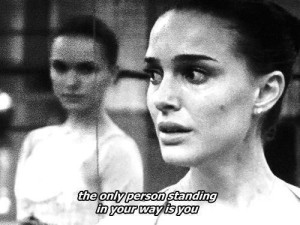
Times Square at night
After months of scheduling conflicts, I finally found myself in NYC with an afternoon to spare. And what better way to spend it than doing and watching ballet?

The Joan Weil Center
I started the morning with a brisk walk down Broadway toward Columbus Circle. The Alvin Ailey Dance Theater is just conveniently located at the corner of 55th and 9th Avenue, a blazing white building in a peaceful Midtown neighbourhood.

The lower lobby of the Joan Weil Center
The advanced beginner class was taught by Bradley Shelver. What a departure from the rigid Vaganova based classes I have been taking for the past months! The barre exercises were mostly what one would expect from an advanced beginner class: tendus, jettees, developpées and the rest, but the emphasis was different. Rather than emphasizing poses and epaulement, the emphasis was on brisk footwork (we did a right left alternating, passé, jettee combo, and boy was I lost!) and spatial awareness. A favorite exercise was grand battement- balance´- attitude relevé combination. Letting go off the barre in the middle of the exercise enhances your ability to move in space. You have to time your balance pretty well to avoid a crash with the barre.
The center adagio was ok. Long, slow, controlled developpe croisée and enface, a transition from arabesque into attitude with a renverse. In the across-the-floor combinations I was lost, hopelessly so. A fast tombe pas de bourrée, followed by jettees right and left, tombe pas de bourree and two glissades. The tempo of the exercise was way over my speed limit, but I gave it a try (and failed).

Despite the rather lackluster performance in the center, I left Alvin Ailey on a ballet high, my stomach bubbling with anticipation for the evening’s Giselle at the Met.

The Metropolitan Opera
The spring-summer season of the ABT at the Met will feature a vast array of ABT principals and guest stars (Natalia Osipova, Roberto Bolle, Diana Vishneva and the rest). The night’s Giselle was performed by ABT principals Xiomara Reyes and Herman Cornejo, with Devon Teuscher in the role of Myrta. First staged in Paris in the late 1800s, Giselle tells the story of a peasant maiden (after whom the ballet is named) and Count Albrecht, who disguises himself as a peasant to win Giselle’s heart. Unfortunately for the lovers, Giselle’s jealous suitor, Hilarion, discovers Albrecht’s true identity and reveals it to Giselle. After learning that the count is already engaged to be married to princess Bathilde, Giselle dies.
The second act opens with a haunting scene, a lone grave in the middle of a forest. Hilarion, who lovingly places, a cross on Giselle’s grave is tormented by appearances of wilis, the phantoms of young maidens disappointed in love. The count also pays his respects to Giselle. While grieving at Giselle’s grave, Albrecht is surrounded by Myrta and the wilis. While Myrta wants to kill Albrecht, Giselle protects him from the wilis and saves his life. As the night ends and the morning sun illuminates the forest clearing where Giselle’s grave is, she retreats leaving Albrecht with one white flower.
The first act featured solid dancing, but veered too much into the theatrical side (which, I admit, is necessary to establish the story). But the second act was truly captivating! Teuscher’s Myrta was a perfect combination of grace and haughty elegance. Every arabesque, every tendu had an air of power and even cruelty. Cornejo, on the other hand, is able to integrate seamless acting and dancing. His futile attempts to capture Giselle’s ghost are a poignant manifestation of Albrecht’s sorrow. Reye’s Giselle, a coy and shy character in the first Act, undergoes a transformation. In the second act, she is no longer powerless. Reyes, perhaps inhibited by the shy peasant-girl role she was portraying in the first act, truly blooms in the complex en diagonal pirouette and grand allegro combinations of the second act.
Although some criticize the classical repertoire for being too fairytale-sweet, there is rarely a sight more breathtaking than the entrance of dozen wilis and Myrta. In that moment, these ballerinas cease to be dancers on a stage. They transform into a mélange of time, space, movement and music.





